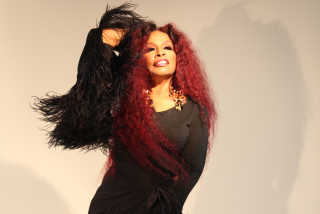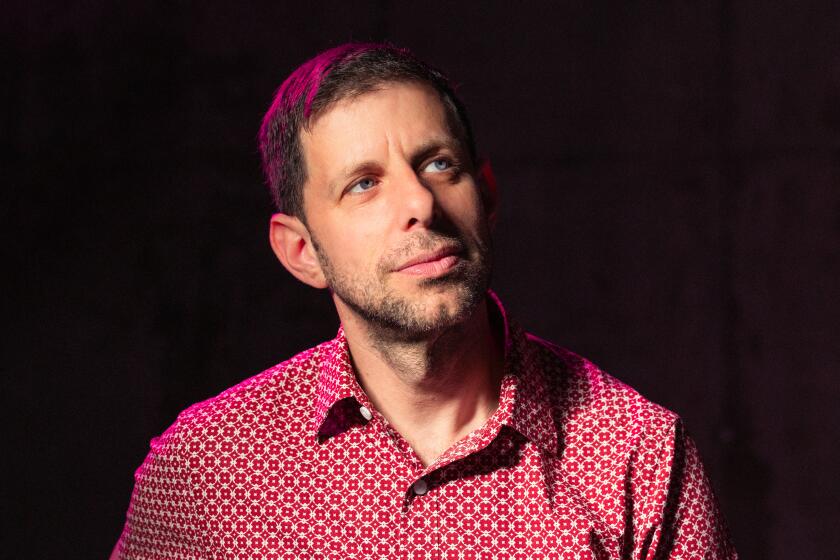As the Border Blurs and the Cultures Become One
An Olmec head has landed, mounted on a lunar landing module, in the Fisher Gallery at USC. Around it are car tires that suggest craters, coiled silver-colored serpents, and an astronaut, a la Neil Armstrong, planting a fluttering American flag--except this spaceman’s suit is encrusted with stone-textured snakes and hands, his backpack contains a giant heart, and the flag is made of perforated sheet metal, mounted on a pole of soldered chain links.
Einar and Jamex de la Torre, brothers based in San Diego and Ensenada, Mexico, are the creators of this elaborate installation that dizzily melds pre-Columbian native mythology, Roman Catholicism and American space exploration. It’s a dramatic statement about the “post-border condition,” which is what the Fisher’s latest exhibition--”Mixed Feelings: Art and Culture in the Postborder Metropolis,” opening Sept. 4--intends to explore.
Thirteen works by 15 artists were commissioned by curators Michael Dear, USC professor of geology and director of the Southern California Studies Center, and Gustavo Leclerc, a trained architect and head of the university’s Border Cultures Project. Because they were particularly interested in addressing “space and place,” the works are all installations and/or videos.
“We were interested in the way art and culture were reflecting urban changes happening around us,” says Dear, sitting with Leclerc in the Fisher Gallery entry as the show is being installed. “A few years ago, we began to look at art and work at the border, the border being the most dynamic place in this country.” He’s talking specifically about the U.S.-Mexico border, although the show investigates other borders as well.
With initial funding from the center and the Fisher Gallery, Dear and Leclerc held a series of meetings with artists and writers who, in their estimation, “were doing interesting work, exploring fluid places to construct identity, hybridity and new types of cosmopolitanism,” Leclerc says. Their aim, Dear says, was for “as much of a variety as possible--cross-race, cross-generational, cross-gender.” Of course, he adds, “they had to be good.”
Most of the participants live and work in the area that stretches from Ventura County to Ensenada, which Dear and Leclerc consider a single metropolis, “Bajalta.” Most are also of Latin descent, and a number, such as the De la Torre brothers, Laura Alvarez or Ruben Ortiz Torres, live part-time in Mexico or visit there regularly.
For the artists, the result is this exhibition; for the writers, a book of essays will be published next year.
The three main Fisher galleries feature three to five works each, with one artist’s work in an annex. Like the De la Torre brothers, most jumble images borrowed from pop culture and show it transformed by border crossings and exchanges. Mark Bradford’s “Jericho” turns a beauty salon chair into an idol, with the nearby doorway framed by cast-plaster praying hands with nails painted in 10 imaginative styles. Ortiz’s “The Garden of Earthly Delights” is a customized lawn mower that dances to music derived from sounds made by Latino gardeners using the tools of their trade. The action is seen on video.
The lunar landing tableau of the De la Torre brothers’ “Colonial Atmosphere” dominates the adjoining gallery. In scale and complexity of elements, it is perhaps the most ambitious of the works. The 10-foot-high Olmec module has custom-made glass panels, some embedded with crushed aluminum cans--brands available on both sides of the border--and a couple of panels replicating the famous Mayan bas-relief in Palenque that UFO fanatics have labeled an ancient space traveler.
In the cockpit, a golden-haired cherub, in the pose of a Christ child and covered with bits of green feathers, stretches out his hands. It’s a reference, according to the brothers, both to the Mayan ruler Pakal and to Quetzalcoatl, the feathered serpent of Toltec mythology.
Other artists focus on more earthbound matters. Marcos Ramirez Erre and Laura Alvarez address the very real phenomenon of Mexican laborers crossing the border to find work. Based in Tijuana and San Diego, Ramirez is a former construction worker who began exhibiting artwork in 1989; one of his installations was included in the Whitney Biennial in 2000.
The Fisher installation, “Walls,” recalls the skills, materials and workaday experiences of his previous occupation. Two walls, one made of brick and one of 2-by-6 framing studs, stand parallel to one another, about six inches apart. Projected onto screens on each are short videos. On the brick side, Mexican workers build a brick-and-mortar wall using the traditional labor-intensive methods.
“It is almost like a caress,” Ramirez says. “It’s not such a rush as on the other side.”
The scenes projected on the other wall show Mexican workers in the U. S. machine-assembling a frame wall with power saws and nail drivers. The videos also include scenes of mealtimes. On the Mexican side of the border, workers put up a makeshift grill, toss on tortillas and share their food. In the U.S., each worker purchases individual meals and beverages from a truck vendor, no sharing. For Ramirez, it’s about two ways of living and how “people tend to lose their own identity when they cross the border.”
While Ramirez’s videos use documentary footage, Alvarez has invented a persona, Double Agent Sirvienta (played by herself), for “Suenos Intermedios” (In Between Dreams). The protagonist is a svelte, model-chic Latina housemaid--who’s actually an undercover agent trying to thwart the corporate takeover of local taco trucks. She “infiltrates” households of wealthy white Westside families to gather information about the enemy.
“Her whole story is existing on both sides of the border,” Alvarez says. California-born and now Santa Monica-based, she has in the past worked cleaning homes. Her character was also inspired by “watching Mexican soap operas where a maid might be a minor character, but she knows what’s really going on in the household, she holds a lot of power.”
Amalia Mesa-Bains is one of the few artists to directly address the border as a physical entity. The Rio Grande is her subject in “What the River Gave to Me.”
“I really wanted to do a river,” says the artist by phone from her home in Monterey. “I’ve been aware of the increasing tensions around the border, the militarization of the border.” For her, the exhibition was a chance to do something different from her familiar altar-like installations dedicated to famous women, a chance to do something a little more abstract.
Set on a platform, “What the River Gave to Me” is made of shattered plate-glass bits cascading between two earth-colored shores. Mexican places of departure and American places of landing are written into the two sides, and the names of those who made the crossing are inscribed on blown-glass orbs that tumble, like bubbles, over the surface of the riverbed. The names are largely illegible, Mesa-Bains says, in order to be evocative rather than specific.
“I’ve started to move into the idea of spiritual landscape,” she says, “where people look for the sign of the sacred in nature itself.” She also considers the work a memorial to those who died crossing the border.
California Conceptualist Norman Yonemoto, who often works as part of a team, with his brother Bruce, chose to address the borders of physical limitation. His “ ‘Self’ Portrait” includes an office cubicle containing a computer with an oversized monitor and a wheelchair--Yonemoto uses a wheelchair because of a stroke.
The monitor shows prerecorded searches on the Internet using his name as the keyword and ends with animation of the continents reuniting. For Leclerc, it’s about “the Internet as a medium to manipulate your borders--you could be anyone.”
Yonemoto says he see globalization as necessary to overcome the concept of the Other, “capital O. The Internet is the symbol for this globalization and how difficult it is to control. As far as I can see there’s no turning back.”
Even after two years of exploration, Dear and Leclerc aren’t so much defining the post-border metropolis as simply identifying it through art.
“We’ve been driven by a question about whether or not there is a post-border art,” Dear says. “My conclusion is that clearly it exists. You can see that in the production of art and the existence of a market that extends beyond New York and Mexico City. Something new is going on here, something new is being manufactured.”
Leclerc doesn’t want to overemphasize geographic or ethnic specificity. Identity and place are important, he says, but these artists “are really consciously looking for a new type of aesthetic.”
Ultimately, what makes the show satisfying are the basics. “These are beautiful pieces,” he says. “They have poetic, complex qualities and multiple dimensions.”
*
“MIXED FEELINGS: ART AND CULTURE IN THE POSTBORDER METROPOLIS,” Fisher Gallery, USC, 823 Exposition Blvd., L.A. Dates: Sept. 4-Dec. 7. Hours are Tuesday-Saturday, noon-5 p.m. Admission: Free. Phone: (213) 740-4561.
*
Scarlet Cheng is a regular contributor to Calendar.
More to Read
The biggest entertainment stories
Get our big stories about Hollywood, film, television, music, arts, culture and more right in your inbox as soon as they publish.
You may occasionally receive promotional content from the Los Angeles Times.






